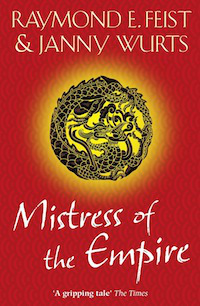Welcome back to the reread of Mistress of the Empire by Raymond E. Feist and Janny Wurts.
This week, as we rattle towards the final conclusion, Tapek (who is the worst) throws a tantrum, and some of Mara’s favourites get their heroic death scenes. It’s gonna get bloody.
Chapter 29: Destruction
SUMMARY: Tapek the Magician is on the rampage, looking for Mara so he can punish her for defying the edict against war with the Anasati.
He locates her litter and honour guard, recognising that two of her senior advisors, Keyoke and Incomo, are travelling with her. Pulling a full ‘bow down and worship me’ performance, he obliterates most of the NPC warriors in the honour guard. The lack of fear and obeisance in the surviving warriors and servants—including Incomo and Keyoke—enrages him.
The litter, with Keyoke alongside it, continues on, and Tapek is even further enraged (it’s amazing he has any left) by the insolent way that Keyoke refuses to order the bearer slaves to stop on his command.
After killing Keyoke with magic (sob!), Tapek obliterates the rest of Mara’s people and tears open the litter only to discover that the dead woman inside is a maid wearing her mistress’s robes.
His fellow Magician Akani arrives to summon Tapek back to the Assembly, and is very scornful about how he has behaved—not even being foresighted enough to let any member of the party live in order to extract information about Mara’s true whereabouts.
It’s more serious than even they suspected—they now believe that Mara’s conspiracy is against the Assembly directly, and that she plans to disrupt their ancient treaty with the cho-ja.
Well. You shouldn’t have made her mad, should you?
The real Mara, meanwhile, escapes this particular attack not only because of her quick thinking, but because of Tapek’s low opinion of her—it never occurred to him that a pampered noblewoman would be able to travel the rough terrain that she chose for her exit route.
She wears borrowed armour, though Saric chides her when she considers using the sword—with no training, there is little point in her raising the weapon except to kill herself if cornered. If they are attacked, her job is to run away.
Mara points out that after all the work Nacoya put into training Saric as an advisor, he had better run away too.
They are approached by a group of support troops in Acoma green, but Saric realises quickly that these are not their own warriors—instead, they are the Minwanabi men who chose not to swear to the Acoma natami when their House was destroyed. Mara’s compassion in letting them live is coming back to bite her.
The realisation comes too late to prevent the attack—Mara flees, and her men seek to slow down their enemy long enough to get her to safety. Saric himself ends up fighting a long and bitter duel to the death, and reflects upon Nacoya and his service to House Acoma as he dies.
COMMENTARY: Aww, Keyoke, no! We’re getting very close to the end of the trilogy so it’s hardly surprising to see the old war horse finally reach his suitably heroic end. It’s still sad, and quite poignant that he died with a sword in his hand, though fighting an impossible opponent: Tapek used magic to make himself intangible against the sword thrust, as well as to land his own killing blow.
Saric too! He was a sweetie, if he never quite rose in characterisation above ‘that slightly less cheeky version of Lujan.’
This is a chapter of two halves, devoted to not only building the danger and tension of the final act of the story, but also acknowledging how far Mara has come, and who has helped her along the way. So much of the Empire trilogy is about how she and her people have broken with tradition, and yet here we see her men stepping up to face their deaths in service to her House in a very traditional manner.
Saric’s half of the chapter—and I think this is actually the first time we have seen any of the story from his point of view—includes several mentions and thoughts of Nacoya, Mara’s original First Advisor and oldest supporter along with Keyoke. It’s fitting that those two iconic characters are honoured here, as the story races towards its conclusion.
Incomo’s death is implied rather than stated, as no one was left alive in Keyoke’s false retinue, and we know he was definitely there. While not as emotionally significant a loss as Keyoke, Saric or Nacoya, he is an important symbolic character because he represents the significant moment when Mara extended her ‘let’s not waste good talent’ policy to those who had served her greatest enemy, the Minwanabi. Despite once dedicating his life to destroying her, and being elderly enough that such a change must have been terrifying to him, Incomo has been a great Advisor and integrated well into the Acoma Found Family.
(Cough, with the loss of Saric and Incomo at the same time, I guess there’s a job opening there for Chumaka, just saying)
It’s important here that we are also shown that Mara’s policy hasn’t been all sunshine, roses and employment contracts. The men who served the Minwanabi are still a threat to her, and her soft-heartedness in letting them live once they rejected her offer has cost her dearly.
Tansy Rayner Roberts is an Australian SF & fantasy author, and a Hugo Award winning blogger and podcaster. Tansy recently completed a serialised novel, Musketeer Space, available to read for free on her blog, and her latest piece of published short fiction is “Fake Geek Girl” at the Australian Review of Fiction. She writes crime fiction under the pen-name of Livia Day. Come and find TansyRR on Twitter & Tumblr, sign up for her Author Newsletter, and listen to her on Galactic Suburbia or the Verity! podcast.










